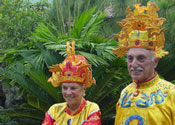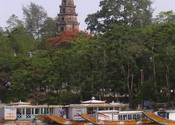|
Hue
This imperial city was the cultural and intellectual center of Vietnam. The citadel-city of Phu Xuan was originally built up during the end of 17th Century and became a political capital as well as the Imperial City of Nguyen Dynasty from 1802 till 2nd September 1945. Over 100 temples, historic sites and old houses have been lost forever, destroyed by war. However, enough of old Hue remains to recall its former glory, when it was the official capital of the Nguyen dynasty for 143 years. Located in the geographic centre of Vietnam, the city still retains its unique cultural identity - unlike most of the country's other cities, which were affected by foreign influences.
 Nowadays, this small & poetical city of 280.000 habitants becomes one of the main tourism site of Vietnam destination by its splendid tombs of the Nguyen Emperors, several notable pagodas especially the Thien Mu Pagoda, the remains of Citadel as well as the romantic Perfume River where a cruise tour with Hue music performance in the moonlight was always provided since long time ago. Nowadays, this small & poetical city of 280.000 habitants becomes one of the main tourism site of Vietnam destination by its splendid tombs of the Nguyen Emperors, several notable pagodas especially the Thien Mu Pagoda, the remains of Citadel as well as the romantic Perfume River where a cruise tour with Hue music performance in the moonlight was always provided since long time ago.
Attractions:
Imperial Citadel & Forbidden City
The Imperial citadel is situated north of the Perfume River. It is the most important historical attraction of Hué and probably the most important historical attraction in all of Vietnam.
The Citadel is a large scale construction covering an area of 5.2 km2. It was built in 1804 under the reign of Gia Long, and completed in 1808, exactly after the model of the palace city in Beijing. It has 10 entrances, and each gate is topped by a watchtower 5m high. Imperial Citadel comprises three ramparts, namely from outside to inside: Kinh Thanh (Capital Citadel), Hoang Thanh (Imperial Citadel) and Tu Cam Thanh (forbidden city).
Stationed in front of the Citadel's main gate, Ngo Mon, in the south-east wall, is a 54.5m flagpole, known as the King's Knight. The emperor entered along the King's Road, also named "Noon" because the emperor's symbol was the sun, which is at its brightest at high noon - although some scholars believe it simply meant the Southern Gate. The main gate has three entrances, with the central one reserved exclusively for the emperor or important foreign ambassadors.
On top of the Noon Gate is the Five Phoenix building, where the emperor appeared on national holidays, such as the My of Sowing the First Seeds and the first day of the lunar year. The east wing of this building was badly damaged during the 1968 battle for Hue. From the Ngo Mon, the Bridge of Golden Waters over the moat leads to the gold-roofed Thai Hoa (Throne Room, or Place of Supreme Harmony), where provincial mandarins came to pay homage. Civil leaders stood on the left, and army chiefs to the right.
A roughly square inside area of about 300 metres to each side was the forbidden city, which only the emperor and his immediate court were allowed to enter. The forbidden city inside is again surrounded by a one meter strong wall. However, the buildings inside the forbidden city were for the most part destroyed during the war, now are under reconstruction providing UNESCO & Japanese non-government associations' fund.
The Museum of Antique (Imperial museum)
This beautiful hall was built in 1845. The most precious artefacts were lost during the war (1954-1973) and the liberation day (1975) but ceramics, furniture and royal relics are remain until the present time.
Thien Mu Pagoda & Perfume River Cruise
Thien Mu Pagoda is situated on Ha Khe Hill, overlooking the Perfume River, 5km from center of Hue. The pagoda is built in 1601 by Gia Long Emperor, 21m-high octagonal tower with seven-storey is one of the most famous structures in all over the country. It is surrounded by flowers and ornamental plants. At the far end of the garden stretches a calm and romantic pine-tree forest. It becomes an unofficial symbol of Hue until now. The pagoda is built in 1601 by Gia Long Emperor, 21m-high octagonal tower with seven-storey is one of the most famous structures in all over the country. It is surrounded by flowers and ornamental plants. At the far end of the garden stretches a calm and romantic pine-tree forest. It becomes an unofficial symbol of Hue until now.
Tu Duc Emperor's Tomb
The most impressive of the Emperor’s tombs and pagodas in Hue. Located on the bank of the Perfume River, 8 km from the center of Hue, this complex has beautiful architecture, intricate decor and military statues. This majestic and serene tomb with lake view, grove of pines, temples, living house area is the most expensive tomb which was completely terminated after 5 years by thousands of labor-worker (1863-1868) for this intellectual-poet emperor. On an area of about 12ha wide, nearly 50 constructions were built on terraces of various levels (about 10m difference). Tu Duc tomb is not only one of the most beautiful works of royal architecture of the Nguyen dynasty but also is a romantic picture of mounts and lakes.
Khai Dinh Emperor's Tomb
This is the final monument of the Nguyen Dynasty. With its stone mandarins, horses and life-size elephants, this is the most famous of the time, construction began during the monarch's lifetime; Located on the slopes of the Chau E Mountain, six miles (10km) south of town, it took 11 years (between 1920 and 1931) and was paid for with a 30 percent tax levied on the whole nation. The complex features ceiling murals, frescoes and a dragon staircase. It is a grandiose concrete tomb which is completely unlike the others tombs where there was a mixture of Romantic, Gothic and Indian styles with notable Buddhist influences, and is decorated from floor to ceiling with mosaics made from vases and pottery brought from all over the empire for the artisans to smash for their work. After climbing 36 steps passing by rows of elephants, horses, civil & military mandarin you will be reached the main building where a full original artefacts are displayed to the public.
Minh Mang Emperor's Tomb
The construction of the tomb of Minh Mang started in 1840 and was completed in 1843. It is located in an enclosed hilly area of 18ha in Cam Khe village, 12 km from the centre of Hue.
Minh Mang tomb is a standard architectural complex consisting of 40 big and small constructions which include palaces, temple, pavilions, etc., designed on symmetric axis along the Dai Hong gate outside to the foot of La Thanh behind the Emperor's tomb.
Visit to Minh Mang tomb, tourists fancy that they are wandering in a world of painting, poetry and philosophy - besides the strictness, majesty and symmetry of the architectural constructions. The tomb of Minh Mang has an air of magnificence and formality, and its architectural design harmoniously blends with its natural surroundings.
Thieu Tri's tomb
Thieu Tri's tomb lies in Chu Chanh village, about 8km from the city. The tomb was built in 1849 and divided into two parts: the tomb area and temple area. Thieu Tri's tomb lies there with simple and intimate beauty, leans its back against the foot of Thuan Dao mount, in front of the tomb stretches flat land with lushly green trees and rice-fields from the Huong river 's bank up to Lim bridge.
Gia Long Emperor's Tomb
The tomb of Gia Long is located 16km from the centre of Hue, on top of the Thien Tho mountain, on the west bank of the Huong river. Construction of the tomb began in 1814 and was completed in 1820. Located in a vast land covered with a wide canopy of old pine trees, the mausoleum was built according to a monumental but simple design. In front is a lotus pond. Behind the pond is a large terraced yard divided into three different levels. The first level was used as the waiting area and is bordered by two rows of elephant and horse statues.
Gia Long's tomb is a wonderful picture of nature and architecture, which provides a superb view of the boundless mountains and the solitary pine forest
Dong Khanh Emperor's Tomb
Dong Khanh tomb is located on the land of Cu Si hamlet. Dong Khanh's Tomb construction lasted through the lives of four Emperors of the Nguyen Dynasty (1888-1923). That's why it bears the stamp of two architectural inclinations of two different historical periods. The whole architecture of the tomb are divided:
The worship temple, in general, the constructions still bear the traditional figures : house with multi succeeding roofs. In the main temple and its dependent houses, the familiar splendid red and gilt pillars with decoration of four seasons and four Holly animals are still seen. Most noteworthy is Ngung Hy temple - the best conserved place of famous red and gilt arts, of famous lacquer arts of Vietnam.
The tomb area: the tomb design was almost completely Europeanized from the architectural peculiarity, decorative model to building materials - Bi Dinh is a variation of Romance architecture blended with Asian architecture with tall, thin mandarin statues from cement and bricks (instead of stone), tile and carreau bricks.
In general, Dong Khanh tomb was beginning of the mixture of European and Asian, of the old and new architecture.
Tu Hieu Pagoda
Pagoda was built in the shape of the Chinese character "Khau" (mouth), with the main building consisting of three rooms and two wings. It faces the southeast and uses Ngu Binh Mount as a front screen, 5km southwest of Hue City.
The pagoda was originally a small hut built by Nhat Dinh in 1843, who was formerly recognized by royal authority as the monk of Giac Hoang Pagoda. In 1848, the pagoda was restored by monk Cung Ky with the help of the king's eunuchs and courtiers. Tu Hieu hence became a large pagoda. The main sanctuary is devoted to the worship of Buddha. Behind there is a room honoring all the eunuchs of the Nguyen Dynasty.
|